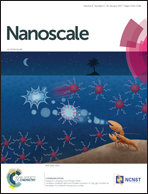Mesoporous carbon nanoshells for high hydrophobic drug loading, multimodal optical imaging, controlled drug release, and synergistic therapy†
Abstract
Loading and controlled release of sufficient hydrophobic drugs to tumor cells has been the bottleneck in chemotherapy for decades. Herein we report the development of a fluorescent and mesoporous carbon nanoshell (FMP-CNS) that exhibits a loading capacity for the hydrophobic drug paclitaxel (PTX) as high as ∼80 wt% and releases the drug in a controllable fashion under NIR irradiation (825 nm) at an intensity of 1.5 W cm−2. The high drug loading is primarily attributed to its mesoporous structure and to the supramolecular π-stacking between FMP-CNSs and PTX molecules. The FMP-CNS also exhibits wavelength-tunable and upconverted fluorescence properties and thus can serve as an optical marker for confocal, two-photon, and near infrared (NIR) fluorescence imaging. Furthermore, our in vitro results indicate that FMP-CNSs demonstrate high therapeutic efficacy through the synergistic effect of combined chemo-photothermal treatment. In vivo studies demonstrate marked suppression of tumor growth in mice bearing rat C6 glioblastoma after administration with a single intratumoral injection of PTX-loaded FMP-CNS.

- This article is part of the themed collection: 2017 Nanoscale HOT Article Collection


 Please wait while we load your content...
Please wait while we load your content...